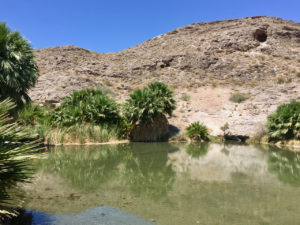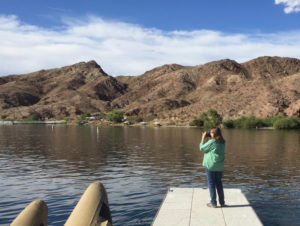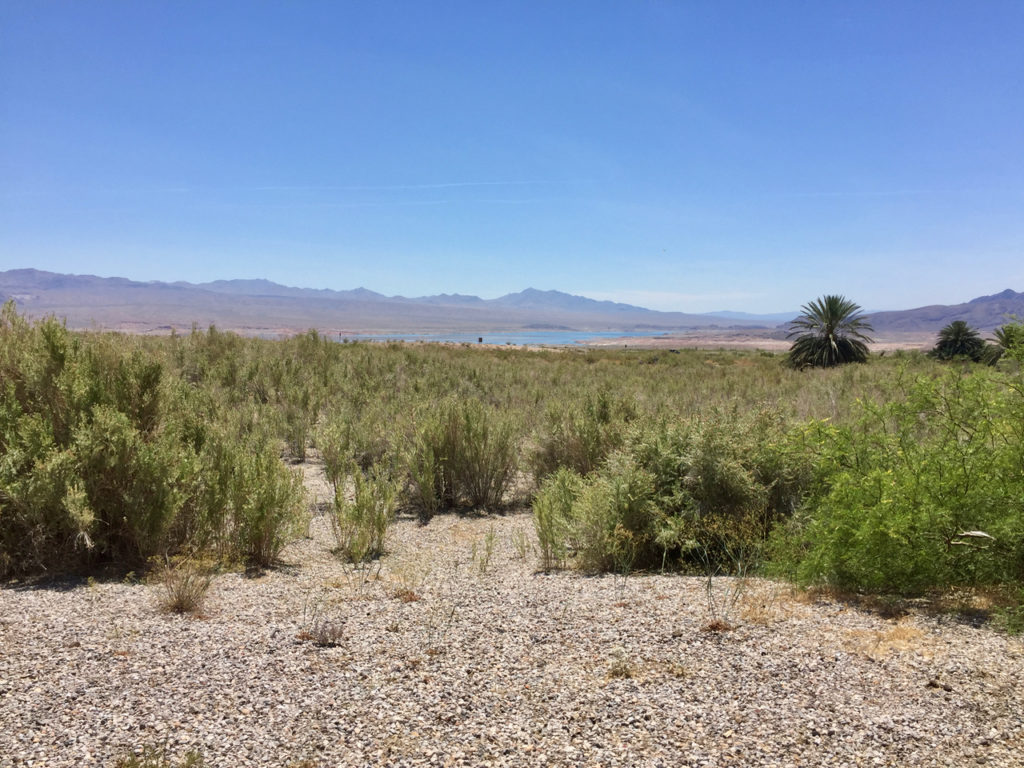ROGERS SPRING – Rogers Spring is a strange apparition in the desert, 400 gallons per minute burbling out of the side of a mountain and down through an oasis of palm trees before the water peters out into the creosote of the Mojave Desert.

Rogers Spring, Lake Mead National Recreation Area
Driving up out of Kingman last Sunday, on our way to Las Vegas, I was moved as I always am by the return to the Mojave Desert of my childhood. The scraggly pacing of the creosote, a bush imbued with chemical magic that helps it drive away neighbors to hoard scarce water for itself and its offspring, always feels like home to me. I grew up in Los Angeles and the deserts to the east, beyond Banning Pass, were my childhood playground.
I live in a desert now, the 9.7 inches of rain a year at my Albuquerque home half that of my Southern California childhood and barely under the arbitrary ten inch definition of desert. And I love my New Mexico deserts. But the Mojave will always have the nostalgic tug of youth, of badly air conditioned cars and tents pitched at the base of Joshua Tree’s boulders.
I wrote well about this five years ago, best just to self-plagiarize for a moment:
We’d largely discarded this place, without meaning to, but realized we can’t. That much was clear as we drove yesterday up through the Pinto Basin in what is now Joshua Tree National Park. By “place” here I mean something big and a bit complicated, but we’ll start by defining it as the deserts of southeastern California. Lissa and I did some of our falling in love here – living in LA and wandering these deserts when we were young and poor and carefree. But that’s only a piece of it, and not the beginning, and certainly not the end. Mom and Dad brought me here from the beginning, camping in one of those big canvas tents. In Boy Scouts – ah, glorious Boy Scouts, where I learned all those unintended lessons – we hiked the desert canyons. When we were old enough to con adults out of car keys (how did we do this?), my friends and I would do the same on our own, freedom defined.
Lissa’s sister Ginnie lived here and died here, a refugee of the city settled into the strange culture that is desert living on society’s fringe. Returning to cope with her death 10 years ago was our last visit, and arguably the most important.
I never lived here, but I learned a lot by visiting.
And so we are back again. In my new career as a professional water nerd, I’ve made the drive from Albuquerque to Las Vegas six or eight times in the last few years (I’m a desert rat, why fly when you can spend a glorious day driving across the desert?). This trip Lissa tagged along, willing to put up with a few days in Las Vegas in trade for some bonus time together before and after in the desert, this desert.

Lissa at Willow Beach
As we approached Las Vegas late Sunday afternoon, we dropped down off the highway to Willow Beach, where the Colorado River shambles out of the bottom end of Black Canyon. Slowed by Hoover Dam upstream and Davis Dam downstream, the Colorado here is more like a narrow, slow-moving lake at Willow Beach, and we parked and walked down onto the marina’s docks to watch folks at play.
There are two things about the desert. Well, there are a lot of things about the desert, but here are two of them. The first is the way aridity makes it possible to begin to see what is going on. The geology is not obscured by things growing atop it, and you begin to see the pieces of an ecosystem in ways you can’t in a wet place. And you can always see the horizon. There are not trees in the way.
The second is the sharp contrast between wet and dry. I have written before about John Van Dyke’s “ribbon of green“, and while I now accept that Van Dyke probably made up much of what we read in his classic book The Desert, the sharp boundary between wet and the dry, between springs or rivers and the desert around them, remains the most interesting thing of all to me about the desert.
So of course Lissa and I turned when we saw the clump of palm trees up against the base of a hill and a short paved road that led up to Rogers Spring. Because water in the desert is an impossibly rare and wonderful thing.
Past the spring, the road bent north, following the Muddy River and then the Virgin, through the kind of desert river valley towns where the idle chitchat with the supermarket checker is about how hot it is and her scheme to have those tunnels like they make for gerbils to get to your car in the desert heat, where gleaming Mormon churches sit across the street from small alfalfa fields (this is the edge of LDS country, where Utah spills into Arizona and Nevada and the alfalfa fields are small).
We’ve got a couple more days of wandering before we have to get back to Albuquerque, and I couldn’t be happier.

Lake Mead’s Overton Arm, in the distance, in the desert

“The geology is not obscured by things growing atop it,…” I recall observing this phenomenon when we moved to New Mexico in 1984. All of those block diagrams in my structural geology textbook finally made sense. Unlike field mapping along the Fall Line of the Piedmont of the mid-Atlantic, or the Pacific Northwest Coast Range, where vegetation was a proxy for weathered bedrock.